Corn Snake
Elaphe guttata
 by Allen Boynton
by Allen Boynton
Updated by Jeff Beane and Matthew Godfrey
North Carolina Wildlife Resources Commission.
Classification
Class: Reptilla
Order: Squamata
Family: Colubridae
Average Size
30 to 48 in.; record 72 in. Males often grow larger than females.
Food
Mostly rodents and other small mammals and birds and their eggs. Juveniles in particular also eat lizards and frogs, especially tree frogs.
Breeding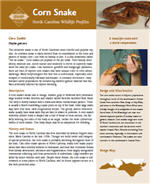
Most mating takes place in the spring. Females lay a clutch of 3 to 31 white, leathery-shelled eggs in late spring, in a damp, sheltered spot such as a rotten log, tree cavity or sawdust pile. Eggs hatch in late summer with no parental care.
Young
Hatchlings average 12 to 14 in. in length, and about the thickness of a pencil. They resemble adults but are normally more drab, with dark reddish brown blotches on a grayish background.
Life Expectancy
One individual lived over 32 years in captivity. Most wild corn snakes probably do not survive to adulthood.
Range and Distribution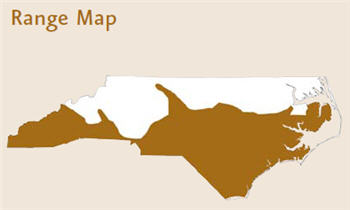
The corn snake occurs in disjunct populations throughout much of the southeastern United States from southern New Jersey to Key West, and west to the Mississippi River. What were initially thought of as subspecies of corn snakes found west of the Mississippi are now considered separate species of snakes, based on genetic research. Corn snakes range over much of North Carolina but are uncommon in the northern mountains and the extreme northeastern Coastal Plain. Records are lacking from some counties, especially in the western and north eastern Piedmont. The snakes are most common in the southeastern Coastal Plain.
General Information
This attractive snake is one of North Carolina’s most colorful and popular reptiles. Its common name is likely derived from its resemblance to the color and pattern of Indian corn—not from its habitat or diet. It is also sometimes called “red rat snake.” Corn snakes are popular in the pet trade. Their beauty, availability, medium size, docile nature and tendency to thrive in captivity make them the ideal pet snake. Like hamsters, gold fish and budgerigar parakeets, there are lines of captive corn snakes that have unique color or even albino markings. Many herpetologists feel that this is unfortunate, especially since escaped or intentionally liberated individuals—a common occurrence—may threaten native populations by introducing harmful genetic material that has been artificially selected by captive breeding.
Descriptio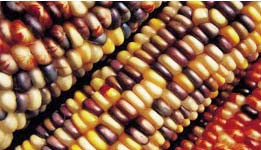 n
n
A corn snake’s dorsal side is orange, reddish, gray or brownish with prominent large reddish brown blotches and smaller lateral blotches bordered with black. The belly is boldly marked with a black-and-white checkerboard pattern. There is usually a blotch resembling a spear point on top of the head. Some large males may have four faint, dark longitudinal stripes. The glossy, almost iridescent scales usually have weak keels that are faint or absent in juveniles. A corn snake’s relatively slender body is shaped like a loaf of bread in cross-section, the flat belly meeting the sides of the body at an angle, unlike the more cylindrical bodies of most snakes. This body shape may be an adaptation for climbing.
History and Status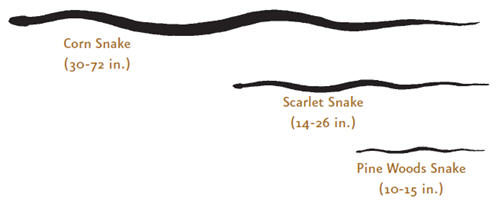
The corn snake in North Carolina was first described by famous English naturalist, Mark Catesby in the late 1700s. Though not listed under any category of special protection, the corn snake is probably declining throughout most of the state. Like other snake species in North Carolina, many corn snake populations have been severely reduced or eliminated, and most face continued threats from habitat destruction, alteration and fragmentation; from largely unregulated commercial collecting; and from persecution of individuals. Large numbers are killed by motor vehicles each year. Despite these threats, the corn snake is still common in some places in North Carolina, and its future appears secure in a few well-protected areas.
Habitat and Habits
Corn snakes inhabit a wide variety of terrestrial habitats in North Carolina. They are most common in the pine-wiregrass flatwoods and sandhills of the central and southern Coastal Plain, and least common in the mountainous areas of Western North Carolina. They climb well when looking for prey in trees, but are also often found on the ground. Corn snakes are largely nocturnal, and individuals are frequently encountered on roads at night. During the day they will often hide under loose bark on logs or dead trees, or take refuge in stump holes or rodent burrows, especially in pine forests. Old building sites with abundant scrap metal and other debris are good places to encounter corn snakes. When frightened or alarmed, a corn snake normally attempts to escape. A cornered individual may assume a defensive posture, vibrating its tail and striking repeatedly. Temperament varies, however, and some specimens never attempt to bite, even when first caught. Like all other North Carolina snakes, corn snakes produce a foul-smelling musk from glands beneath the base of their tail. Corn snakes kill active prey — larg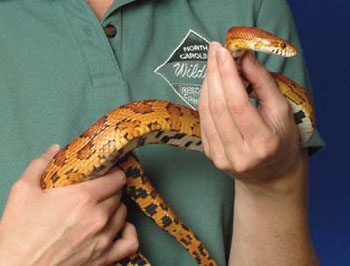 ely mice, other small mammals, and even birds — by constriction. Their natural predators include hawks, carnivorous mammals, eastern kingsnakes and black racers. In winter, corn snakes hibernate in burrows below the frost line, but they may emerge to bask on warm days.
ely mice, other small mammals, and even birds — by constriction. Their natural predators include hawks, carnivorous mammals, eastern kingsnakes and black racers. In winter, corn snakes hibernate in burrows below the frost line, but they may emerge to bask on warm days.
People Interactions
Interactions between humans and corn snakes run from one extreme to the other. M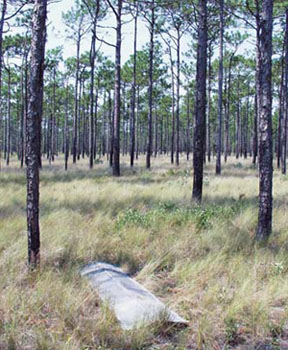 any persons still hate and fear snakes and kill the completely harmless corn snake on sight, either mistaking it for a venomous species or simply killing it because it is a snake. Other people breed corn snakes in a bewildering array of color and pattern mutations to meet an ever-increasing demand for these animals as pets. Corn snakes eat rodents and may thus be considered “economically beneficial.” As pets they may provide their keepers enjoyment, as well as some measure of appreciation for snakes and other creatures. There is also money to be made selling corn snakes, and they must thus be considered commercially valuable. Overall, corn snakes are one of the many amazing reptiles of North Carolina that deserve respect and should be allowed to live unhampered in natural habitats.
any persons still hate and fear snakes and kill the completely harmless corn snake on sight, either mistaking it for a venomous species or simply killing it because it is a snake. Other people breed corn snakes in a bewildering array of color and pattern mutations to meet an ever-increasing demand for these animals as pets. Corn snakes eat rodents and may thus be considered “economically beneficial.” As pets they may provide their keepers enjoyment, as well as some measure of appreciation for snakes and other creatures. There is also money to be made selling corn snakes, and they must thus be considered commercially valuable. Overall, corn snakes are one of the many amazing reptiles of North Carolina that deserve respect and should be allowed to live unhampered in natural habitats.
NCWRC Interaction
Corn snakes are relatively common throughout much of N.C. and the monitoring of corn snake populations can quickly alert biologists to any potential declines. At home primarily in upland habitats, the corn snake has the potential to experience reduced populations as these high and dry areas are often prized as construction sites. One way to monitor corn snakes is through the use of artificial cover materials consisting of plywood boards, concrete blocks, roofing shingles and other materials. Roofing tin seems to be the most effective material to attract these snakes. Snakes will seek out these sheets of metal for thermoregulation and as a result, this method is particularly successful during spring and fall.
References:
Behler, J.L., and F.W. King. The Audubon Society Field Guide to North American Reptiles and Amphibians (New York: Alfred A. Knopf, 1979).
Burbrink, Frank T. Phylogeographic analysis of the cornsnake (Elaphe guttata) complex as inferred from maximum likelihood and Bayesian analyses. (Molecular Phylogenetics and
Evolution, Vol. 25: 465–476, 2002).
Conant, Roger and Joseph Collins. A Field Guide to Reptiles And Amphibians of Eastern and Central North America (Boston: Houghton Mifflin Co., 1991).
Dorcas, Michael E. A Guide to the Snakes of North Carolina (Ophidian Publishers, 2005).
Ernst, C.H., and R. W. Barbour, Turtles of the United States (Lexington: Univ. Press of Kentucky, 1971).
Gibbons, W. and Michael E. Dorcas. Snakes of the Southeast (University of Georgia Press, 2005).
Herman, Dennis. “Tracking the Rare Bog Turtle,” in Wildlife in North Carolina (October 1989).
Credits:
Illustrated by J.T. Newman. Photos by North Carolina Wildlife Resources Commission.
Produced by the Division of Conservation Education, Cay Cross–Editor.

17 June 2010 | Beane, Jeff; Boynton, Allen; Godfrey, Matthew